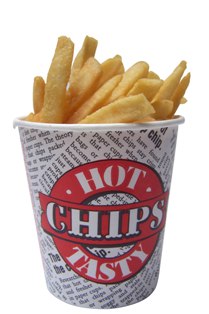The skinny on chips
Written by Catherine Saxelby
on Monday, 28 September 2009.
Tagged: carbohydrates, fast food, fat, junk food, overweight, snacks, take-away, weight loss
Yummm! There's something so enticing about the aroma of hot chips on a cold winter's day that it's hard to say No. Whether straight-cut, crinkle-cut, fries or wedges, Australians consume a staggering 250 million serves of chips each year. They are the standard accompaniment to most fast food and also to kids' meals at restaurants.
 Hot chips and fries are ranked as the second most popular take-away in Australia (after hamburgers). And they're amazingly popular with children and teens - parents often buy them as "whinge food", an inexpensive way to keep the kids quiet and happy for 10 minutes when shopping.
Hot chips and fries are ranked as the second most popular take-away in Australia (after hamburgers). And they're amazingly popular with children and teens - parents often buy them as "whinge food", an inexpensive way to keep the kids quiet and happy for 10 minutes when shopping.
The bad news
Yet chips get the thumbs down due their high fat content of around 15 per cent. Doesn't sound much as a percentage but this translates to a whopping 23 grams of fat from an average bucket of hot chips. And they're an amazing vehicle for taking in excess salt.
Because of the type of fats used for deep drying, the fat in chips is generally saturated fat, the type that can raise blood cholesterol and contribute to heart problems.
What's so sad is that the potato, the raw ingredient of chips, is a nutritious food to start with, being fat-free and filling in its boiled or baked state.
Making chips healthier
But the good news is that there are ways to make the humble chip better for you, according to the National Heart Foundation.
Back in the 1990s, it undertook a survey of 160 take-away food shops in NSW Australia. It found that only around half cooked chips at the recommended temperature and that half of their fryer thermostats were inaccurate.
If the temperature is too low: chips take longer to cook and tend to absorb more oil.
If the temperature is too high: the chips turn out dark and the oil becomes "damaged", developing off flavours which are transferred to the chips and creating potential carcinogens (cancer-causing compounds).
It also saves the shop money as less oil is used and the life of the frying oil is extended.
The type of chip further determines the final fat level, as the greater the surface area of the chip, the more oil is absorbed. Thus thick straight-cut chips and potato wedges have a smaller surface area than thin chips, fries or crinkle cut (see below), so they will be lower in fat and kilojoules (calories).
Tips on chips for fast food operators
The National Heart Foundation has summarised all this with its "Tips on chips" which it offers to take-away shops.
1. Cook chips at 180-185ºC (356-365°F) for about 3 minutes. Turn the thermostat down to 140ºC or less (285°F or less) when not frying to preserve the life of the oil
2. Use bigger thicker chips, 12 mm or bigger, and don't let them thaw before cooking (thawed chips release more water into the oil and lower the oil temperature).
3. Keep the oil clean by skimming the surface and filtering regularly. Use a good quality oil such as sunola, a variety of sunflower oil with excellent stability for deep frying. Unfortunately it is relatively unknown and more expensive than other oils.
Using these three tips, the fat count of chips can be cut back as low as 9 per cent - not the world's lowest-fat food but at least better than you!
French fries spawn a whole new potato
Fries and crisps account for around half of Australia's one million tonne potato crop, yet they demand a very different potato from the one destined to be boiled or mashed.
To make the perfect long French fry, the potato must be:
- long rather than round
- have a higher starch content
- have a lower moisture content
- be lowish in sugar, so that they will not char or caramelise upon frying.
So specific are the requirements of French fries that a special potato variety "Russet Burbank" is grown exclusively in Tasmania for one large fast food chain.
The fattening of the potato
Check out how a fat-free food becomes a high-fat munch
(Figures are in grams per 100 grams or per cent)
Boiled or baked in its jacket
Fat 0 grams
Roasted in oil
Fat 10 grams
Chips
Fat 15 grams
Chips, oven-baked straight-cut
Fat 3-4 grams
Chips, oven-baked, crinkle cut
Fat 8 grams
Wedges, crunchy coated, oven-baked
Fat 9 grams
Fries
Fat 18 grams
You may also be interested in...
Foodwatch
The Good Stuff
The Boring Stuff
© 2025 Foodwatch Australia. All rights reserved
Website by Joomstore eCommerce





